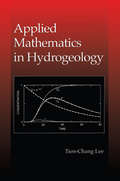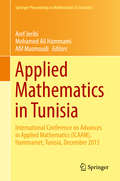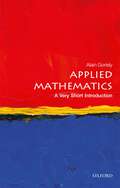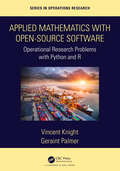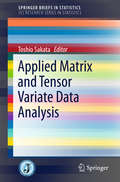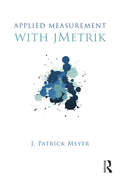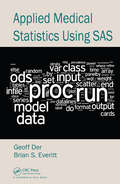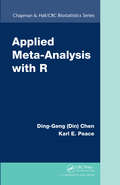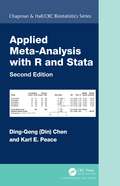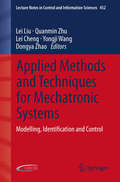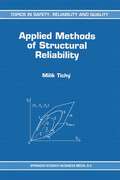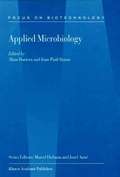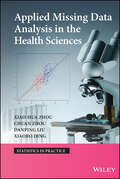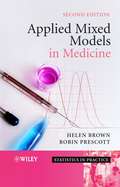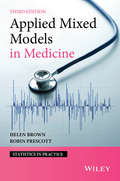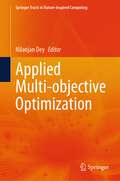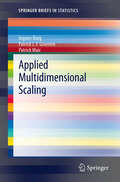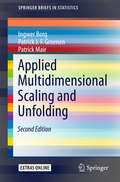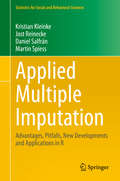- Table View
- List View
Applied Mathematics in Hydrogeology
by Tien-Chang LeeAs introduced in Dr. Lee's 10-week class, Applied Mathematics in Hydrogeology is written for professionals and graduate students who have a keen interest in the application of mathematics in hydrogeology.Its first seven chapters cover analytical solutions for problems commonly encountered in the study of quantitative hydrogeology, while the final three chapters focus on solving linear simultaneous equations, finite element analysis, and inversion for parameter determination.Dr. Lee provides various equation-solving methods that are of interest to hydrogeologists, geophysicists, soil scientists, and civil engineers, as well as applied physicists and mathematicians. In the classroom, this same information will help students realize how familiar equations in hydrogeology are derived-an important step toward development of a student's own mathematical models.Unlike other applied mathematics books that are structured according to systematic methodology, Applied Mathematics in Hydrogeology emphasizes equation-solving methods according to topics. Hydrogeological problems and governing differential equations are introduced, including hydraulic responses to pumping in confined and unconfined aquifers, as well as transport of heat and solute in flowing groundwater.
Applied Mathematics in Tunisia: International Conference on Advances in Applied Mathematics (ICAAM), Hammamet, Tunisia, December 2013 (Springer Proceedings in Mathematics & Statistics #131)
by Aref Jeribi Mohamed Ali Hammami Afif MasmoudiThis contributed volume presents some recent theoretical advances in mathematics and its applications in various areas of science and technology. Written by internationally recognized scientists and researchers, the chapters in this book are based on talks given at the International Conference on Advances in Applied Mathematics (ICAAM), which took place December 16-19, 2013, in Hammamet, Tunisia. Topics discussed at the conference included spectral theory, operator theory, optimization, numerical analysis, ordinary and partial differential equations, dynamical systems, control theory, probability, and statistics. These proceedings aim to foster and develop further growth in all areas of applied mathematics.
Applied Mathematics: A Very Short Introduction (Very Short Introductions)
by Alain GorielyMathematics is playing an increasing important role in society and the sciences, enhancing our ability to use models and handle data. While pure mathematics is mostly interested in abstract structures, applied mathematics sits at the interface between this abstract world and the world in which we live. This area of mathematics takes its nourishment from society and science and, in turn, provides a unified way to understand problems arising in diverse fields. This Very Short Introduction presents a compact yet comprehensive view of the field of applied mathematics, and explores its relationships with (pure) mathematics, science, and engineering. Explaining the nature of applied mathematics, Alain Goriely discusses its early achievements in physics and engineering, and its development as a separate field after World War II. Using historical examples, current applications, and challenges, Goriely illustrates the particular role that mathematics plays in the modern sciences today and its far-reaching potential. ABOUT THE SERIES: The Very Short Introductions series from Oxford University Press contains hundreds of titles in almost every subject area. These pocket-sized books are the perfect way to get ahead in a new subject quickly. Our expert authors combine facts, analysis, perspective, new ideas, and enthusiasm to make interesting and challenging topics highly readable.
Applied Mathematics: A Very Short Introduction (Very Short Introductions #45)
by Alain GorielyMathematics is playing an increasing important role in society and the sciences, enhancing our ability to use models and handle data. While pure mathematics is mostly interested in abstract structures, applied mathematics sits at the interface between this abstract world and the world in which we live. This area of mathematics takes its nourishment from society and science and, in turn, provides a unified way to understand problems arising in diverse fields. This Very Short Introduction presents a compact yet comprehensive view of the field of applied mathematics, and explores its relationships with (pure) mathematics, science, and engineering. Explaining the nature of applied mathematics, Alain Goriely discusses its early achievements in physics and engineering, and its development as a separate field after World War II. Using historical examples, current applications, and challenges, Goriely illustrates the particular role that mathematics plays in the modern sciences today and its far-reaching potential. ABOUT THE SERIES: The Very Short Introductions series from Oxford University Press contains hundreds of titles in almost every subject area. These pocket-sized books are the perfect way to get ahead in a new subject quickly. Our expert authors combine facts, analysis, perspective, new ideas, and enthusiasm to make interesting and challenging topics highly readable.
Applied Mathematics with Open-Source Software: Operational Research Problems with Python and R (Chapman & Hall/CRC Series in Operations Research)
by Vincent Knight Geraint PalmerApplied Mathematics with Open-source Software: Operational Research Problems with Python and R is aimed at a broad segment of readers who wish to learn how to use open-source software to solve problems in applied mathematics. The book has an innovative structure with 4 sections of two chapters covering a large range of applied mathematical techniques: probabilistic modelling, dynamical systems, emergent behaviour and optimisation. The pairs of chapters in each section demonstrate different families of solution approaches. Each chapter starts with a problem, gives an overview of the relevant theory, shows a solution approach in R and in Python, and finally gives wider context by including a number of published references. This structure will allow for maximum accessibility, with minimal prerequisites in mathematics or programming as well as giving the right opportunities for a reader wanting to delve deeper into a particular topic. Features An excellent resource for scholars of applied mathematics and operational research, and indeed any academics who want to learn how to use open-source software. Offers more general and accessible treatment of the subject than other texts, both in terms of programming language but also in terms of the subjects considered. The R and Python sections purposefully mirror each other so that a reader can read only the section that interests them. An accompanying open-source repository with source files and further examples is posted online at https://bit.ly/3kpoKSd.
Applied Mathematics with Open-Source Software: Operational Research Problems with Python and R (Chapman & Hall/CRC Series in Operations Research)
by Vincent Knight Geraint PalmerApplied Mathematics with Open-source Software: Operational Research Problems with Python and R is aimed at a broad segment of readers who wish to learn how to use open-source software to solve problems in applied mathematics. The book has an innovative structure with 4 sections of two chapters covering a large range of applied mathematical techniques: probabilistic modelling, dynamical systems, emergent behaviour and optimisation. The pairs of chapters in each section demonstrate different families of solution approaches. Each chapter starts with a problem, gives an overview of the relevant theory, shows a solution approach in R and in Python, and finally gives wider context by including a number of published references. This structure will allow for maximum accessibility, with minimal prerequisites in mathematics or programming as well as giving the right opportunities for a reader wanting to delve deeper into a particular topic. Features An excellent resource for scholars of applied mathematics and operational research, and indeed any academics who want to learn how to use open-source software. Offers more general and accessible treatment of the subject than other texts, both in terms of programming language but also in terms of the subjects considered. The R and Python sections purposefully mirror each other so that a reader can read only the section that interests them. An accompanying open-source repository with source files and further examples is posted online at https://bit.ly/3kpoKSd.
Applied Matrix and Tensor Variate Data Analysis (SpringerBriefs in Statistics)
by Toshio SakataThis book provides comprehensive reviews of recent progress in matrix variate and tensor variate data analysis from applied points of view. Matrix and tensor approaches for data analysis are known to be extremely useful for recently emerging complex and high-dimensional data in various applied fields. The reviews contained herein cover recent applications of these methods in psychology (Chap. 1), audio signals (Chap. 2) , image analysis from tensor principal component analysis (Chap. 3), and image analysis from decomposition (Chap. 4), and genetic data (Chap. 5) . Readers will be able to understand the present status of these techniques as applicable to their own fields. In Chapter 5 especially, a theory of tensor normal distributions, which is a basic in statistical inference, is developed, and multi-way regression, classification, clustering, and principal component analysis are exemplified under tensor normal distributions. Chapter 6 treats one-sided tests under matrix variate and tensor variate normal distributions, whose theory under multivariate normal distributions has been a popular topic in statistics since the books of Barlow et al. (1972) and Robertson et al. (1988). Chapters 1, 5, and 6 distinguish this book from ordinary engineering books on these topics.
Applied Measurement with jMetrik
by J. Patrick MeyerjMetrik is a computer program for implementing classical and modern psychometric methods. It is designed to facilitate work in a production environment and to make advanced psychometric procedures accessible to every measurement practitioner. Applied Measurement with jMetrik reviews psychometric theory and describes how to use jMetrik to conduct a comprehensive psychometric analysis. Each chapter focuses on a topic in measurement, describes the steps for using jMetrik, and provides one or more examples of conducting an analysis on the topic. Recommendations and guidance for practice is provided throughout the book.
Applied Measurement with jMetrik
by J. Patrick MeyerjMetrik is a computer program for implementing classical and modern psychometric methods. It is designed to facilitate work in a production environment and to make advanced psychometric procedures accessible to every measurement practitioner. Applied Measurement with jMetrik reviews psychometric theory and describes how to use jMetrik to conduct a comprehensive psychometric analysis. Each chapter focuses on a topic in measurement, describes the steps for using jMetrik, and provides one or more examples of conducting an analysis on the topic. Recommendations and guidance for practice is provided throughout the book.
Applied Medical Statistics Using SAS
by Geoff Der Brian S. EverittWritten with medical statisticians and medical researchers in mind, this intermediate-level reference explores the use of SAS for analyzing medical data. Applied Medical Statistics Using SAS covers the whole range of modern statistical methods used in the analysis of medical data, including regression, analysis of variance and covariance, longitudi
Applied Meta-Analysis with R: Applied Meta-analysis With R
by Ding-Geng (Din) Chen Karl E. PeaceIn biostatistical research and courses, practitioners and students often lack a thorough understanding of how to apply statistical methods to synthesize biomedical and clinical trial data. Filling this knowledge gap, Applied Meta-Analysis with R shows how to implement statistical meta-analysis methods to real data using R. Drawing on their extensiv
Applied Meta-Analysis with R and Stata (Chapman & Hall/CRC Biostatistics Series)
by Ding-Geng (Din) Chen Karl E. PeaceReview of the First Edition: The authors strive to reduce theory to a minimum, which makes it a self-learning text that is comprehensible for biologists, physicians, etc. who lack an advanced mathematics background. Unlike in many other textbooks, R is not introduced with meaningless toy examples; instead the reader is taken by the hand and shown around some analyses, graphics, and simulations directly relating to meta-analysis… A useful hands-on guide for practitioners who want to familiarize themselves with the fundamentals of meta-analysis and get started without having to plough through theorems and proofs. —Journal of Applied Statistics Statistical Meta-Analysis with R and Stata, Second Edition provides a thorough presentation of statistical meta-analyses (MA) with step-by-step implementations using R/Stata. The authors develop analysis step by step using appropriate R/Stata functions, which enables readers to gain an understanding of meta-analysis methods and R/Stata implementation so that they can use these two popular software packages to analyze their own meta-data. Each chapter gives examples of real studies compiled from the literature. After presenting the data and necessary background for understanding the applications, various methods for analyzing meta-data are introduced. The authors then develop analysis code using the appropriate R/Stata packages and functions. What’s New in the Second Edition: Adds Stata programs along with the R programs for meta-analysis Updates all the statistical meta-analyses with R/Stata programs Covers fixed-effects and random-effects MA, meta-regression, MA with rare-event, and MA-IPD vs MA-SS Adds five new chapters on multivariate MA, publication bias, missing data in MA, MA in evaluating diagnostic accuracy, and network MA Suitable as a graduate-level text for a meta-data analysis course, the book is also a valuable reference for practitioners and biostatisticians (even those with little or no experience in using R or Stata) in public health, medical research, governmental agencies, and the pharmaceutical industry.
Applied Meta-Analysis with R and Stata (Chapman & Hall/CRC Biostatistics Series)
by Ding-Geng (Din) Chen Karl E. PeaceReview of the First Edition: The authors strive to reduce theory to a minimum, which makes it a self-learning text that is comprehensible for biologists, physicians, etc. who lack an advanced mathematics background. Unlike in many other textbooks, R is not introduced with meaningless toy examples; instead the reader is taken by the hand and shown around some analyses, graphics, and simulations directly relating to meta-analysis… A useful hands-on guide for practitioners who want to familiarize themselves with the fundamentals of meta-analysis and get started without having to plough through theorems and proofs. —Journal of Applied Statistics Statistical Meta-Analysis with R and Stata, Second Edition provides a thorough presentation of statistical meta-analyses (MA) with step-by-step implementations using R/Stata. The authors develop analysis step by step using appropriate R/Stata functions, which enables readers to gain an understanding of meta-analysis methods and R/Stata implementation so that they can use these two popular software packages to analyze their own meta-data. Each chapter gives examples of real studies compiled from the literature. After presenting the data and necessary background for understanding the applications, various methods for analyzing meta-data are introduced. The authors then develop analysis code using the appropriate R/Stata packages and functions. What’s New in the Second Edition: Adds Stata programs along with the R programs for meta-analysis Updates all the statistical meta-analyses with R/Stata programs Covers fixed-effects and random-effects MA, meta-regression, MA with rare-event, and MA-IPD vs MA-SS Adds five new chapters on multivariate MA, publication bias, missing data in MA, MA in evaluating diagnostic accuracy, and network MA Suitable as a graduate-level text for a meta-data analysis course, the book is also a valuable reference for practitioners and biostatisticians (even those with little or no experience in using R or Stata) in public health, medical research, governmental agencies, and the pharmaceutical industry.
Applied Methods and Techniques for Mechatronic Systems: Modelling, Identification and Control (Lecture Notes in Control and Information Sciences #452)
by Lei Liu Quanmin Zhu Lei Cheng Yongji Wang Dongya ZhaoApplied Methods and Techniques for Mechatronic Systems brings together the relevant studies in mechatronic systems with the latest research from interdisciplinary theoretical studies, computational algorithm development and exemplary applications. Readers can easily tailor the techniques in this book to accommodate their ad hoc applications. The clear structure of each paper, background - motivation - quantitative development (equations) - case studies/illustration/tutorial (curve, table, etc.) is also helpful. It is mainly aimed at graduate students, professors and academic researchers in related fields, but it will also be helpful to engineers and scientists from industry.Lei Liu is a lecturer at Huazhong University of Science and Technology (HUST), China; Quanmin Zhu is a professor at University of the West of England, UK; Lei Cheng is an associate professor at Wuhan University of Science and Technology, China; Yongji Wang is a professor at HUST; Dongya Zhao is an associate professor at China University of Petroleum.
Applied Methods of Structural Reliability (Topics in Safety, Reliability and Quality #2)
by Milík TichýA quarter of the century has elapsed since I gave my first course in structural reliability to graduate students at the University of Waterloo in Canada. Since that time on I have given many courses and seminars to students, researchers, designers, and site engineers interested in reliability. I also participated in and was responsible for numerous projects where reliability solutions were required. During that period, the scope of structural reliability gradually enlarged to become a substantial part of the general reliability theory. First, it is apparent that bearing structures should not be isolated objectives of interest, and, consequently, that constntCted facilities should be studied. Second, a new engineering branch has emerged -reliability engineering. These two facts have highlighted new aspects and asked for new approaches to the theory and applications. I always state in my lectures that the reliability theory is nothing more than mathematized engineering judgment. In fact, thanks mainly to probability and statistics, and also to computers, the empirical knowledge gained by Humankind's construction experience could have been transposed into a pattern of logic thinking, able to produce conclusions and to forecast the behavior of engineering entities. This manner of thinking has developed into an intricate network linked by certain rules, which, in a way, can be considered a type of reliability grammar. We can discern many grammatical concepts in the general structure of the reliability theory.
Applied Microbiology (Focus on Biotechnology #2)
by A. Durieux J. P. SimonThis book illustrates the major trends in applied microbiology research with immediate or potential industrial applications. The papers proposed reflect the diversity of the application fields. New microbial developments have been done as well in the food and health sectors than in the environmental technology or in the fine chemical production. All the microbial genera are involved : yeast, fungi and bacteria. The development of biotechnology in parallel with the industrial microbiology has enabled the application of microbial diversity to our socio-economical world. The remarkable properties of microbes, inherent in their genetic and enzymatic material, allow a wide range of applications that can improve our every day life. Recent studies for elucidating the molecular basis of the physiological processes in micro-organisms are essential to improve and to control the metabolic pathways to overproduce metabolites or enzymes of industrial interest. The genetic engineering is of course one of the disciplines offering new horizons for the « fantastic microbial factory » . Studies of the culture parameter incidence on the physiology and the morphology are essential to control the response of the micro-organisms before its successful exploitation at the industrial scale. For this purpose, fundamental viewpoints are necessary. Development of novel approaches to characterise micro-organisms would also facilitate the understanding of the inherent metabolic diversity of the microbial world, in terms of adaptation to a wide range of biotopes and establishment of microbial consortia.
Applied Missing Data Analysis in the Health Sciences (Statistics in Practice #81)
by Xiao-Hua Zhou Chuan Zhou Danping Lui Xaiobo DingA modern and practical guide to the essential concepts and ideas for analyzing data with missing observations in the field of biostatistics With an emphasis on hands-on applications, Applied Missing Data Analysis in the Health Sciences outlines the various modern statistical methods for the analysis of missing data. The authors acknowledge the limitations of established techniques and provide newly-developed methods with concrete applications in areas such as causal inference methods and the field of diagnostic medicine. Organized by types of data, chapter coverage begins with an overall introduction to the existence and limitations of missing data and continues into traditional techniques for missing data inference, including likelihood-based, weighted GEE, multiple imputation, and Bayesian methods. The book’s subsequently covers cross-sectional, longitudinal, hierarchical, survival data. In addition, Applied Missing Data Analysis in the Health Sciences features: Multiple data sets that can be replicated using the SAS®, Stata®, R, and WinBUGS software packages Numerous examples of case studies in the field of biostatistics to illustrate real-world scenarios and demonstrate applications of discussed methodologies Detailed appendices to guide readers through the use of the presented data in various software environments Applied Missing Data Analysis in the Health Sciences is an excellent textbook for upper-undergraduate and graduate-level biostatistics courses as well as an ideal resource for health science researchers and applied statisticians.
Applied Missing Data Analysis in the Health Sciences (Statistics in Practice)
by Xiao-Hua Zhou Chuan Zhou Danping Lui Xaiobo DingA modern and practical guide to the essential concepts and ideas for analyzing data with missing observations in the field of biostatistics With an emphasis on hands-on applications, Applied Missing Data Analysis in the Health Sciences outlines the various modern statistical methods for the analysis of missing data. The authors acknowledge the limitations of established techniques and provide newly-developed methods with concrete applications in areas such as causal inference methods and the field of diagnostic medicine. Organized by types of data, chapter coverage begins with an overall introduction to the existence and limitations of missing data and continues into traditional techniques for missing data inference, including likelihood-based, weighted GEE, multiple imputation, and Bayesian methods. The book’s subsequently covers cross-sectional, longitudinal, hierarchical, survival data. In addition, Applied Missing Data Analysis in the Health Sciences features: Multiple data sets that can be replicated using the SAS®, Stata®, R, and WinBUGS software packages Numerous examples of case studies in the field of biostatistics to illustrate real-world scenarios and demonstrate applications of discussed methodologies Detailed appendices to guide readers through the use of the presented data in various software environments Applied Missing Data Analysis in the Health Sciences is an excellent textbook for upper-undergraduate and graduate-level biostatistics courses as well as an ideal resource for health science researchers and applied statisticians.
Applied Mixed Models in Medicine (Statistics in Practice)
by Helen Brown Robin PrescottA mixed model allows the incorporation of both fixed and random variables within a statistical analysis. This enables efficient inferences and more information to be gained from the data. The application of mixed models is an increasingly popular way of analysing medical data, particularly in the pharmaceutical industry. There have been many recent advances in mixed modelling, particularly regarding the software and applications. This new edition of a groundbreaking text discusses the latest developments, from updated SAS techniques to the increasingly wide range of applications. Presents an overview of the theory and applications of mixed models in medical research, including the latest developments and new sections on bioequivalence, cluster randomised trials and missing data. Easily accessible to practitioners in any area where mixed models are used, including medical statisticians and economists. Includes numerous examples using real data from medical and health research, and epidemiology, illustrated with SAS code and output. Features new version of SAS, including the procedure PROC GLIMMIX and an introduction to other available software. Supported by a website featuring computer code, data sets, and further material, available at: http://www.chs.med.ed.ac.uk/phs/mixed/. This much-anticipated second edition is ideal for applied statisticians working in medical research and the pharmaceutical industry, as well as teachers and students of statistics courses in mixed models. The text will also be of great value to a broad range of scientists, particularly those working the medical and pharmaceutical areas.
Applied Mixed Models in Medicine (Statistics in Practice #28)
by Helen Brown Robin PrescottA fully updated edition of this key text on mixed models, focusing on applications in medical research The application of mixed models is an increasingly popular way of analysing medical data, particularly in the pharmaceutical industry. A mixed model allows the incorporation of both fixed and random variables within a statistical analysis, enabling efficient inferences and more information to be gained from the data. There have been many recent advances in mixed modelling, particularly regarding the software and applications. This third edition of Brown and Prescott’s groundbreaking text provides an update on the latest developments, and includes guidance on the use of current SAS techniques across a wide range of applications. Presents an overview of the theory and applications of mixed models in medical research, including the latest developments and new sections on incomplete block designs and the analysis of bilateral data. Easily accessible to practitioners in any area where mixed models are used, including medical statisticians and economists. Includes numerous examples using real data from medical and health research, and epidemiology, illustrated with SAS code and output. Features the new version of SAS, including new graphics for model diagnostics and the procedure PROC MCMC. Supported by a website featuring computer code, data sets, and further material. This third edition will appeal to applied statisticians working in medical research and the pharmaceutical industry, as well as teachers and students of statistics courses in mixed models. The book will also be of great value to a broad range of scientists, particularly those working in the medical and pharmaceutical areas.
Applied Mixed Models in Medicine (Statistics in Practice)
by Helen Brown Robin PrescottA fully updated edition of this key text on mixed models, focusing on applications in medical research The application of mixed models is an increasingly popular way of analysing medical data, particularly in the pharmaceutical industry. A mixed model allows the incorporation of both fixed and random variables within a statistical analysis, enabling efficient inferences and more information to be gained from the data. There have been many recent advances in mixed modelling, particularly regarding the software and applications. This third edition of Brown and Prescott’s groundbreaking text provides an update on the latest developments, and includes guidance on the use of current SAS techniques across a wide range of applications. Presents an overview of the theory and applications of mixed models in medical research, including the latest developments and new sections on incomplete block designs and the analysis of bilateral data. Easily accessible to practitioners in any area where mixed models are used, including medical statisticians and economists. Includes numerous examples using real data from medical and health research, and epidemiology, illustrated with SAS code and output. Features the new version of SAS, including new graphics for model diagnostics and the procedure PROC MCMC. Supported by a website featuring computer code, data sets, and further material. This third edition will appeal to applied statisticians working in medical research and the pharmaceutical industry, as well as teachers and students of statistics courses in mixed models. The book will also be of great value to a broad range of scientists, particularly those working in the medical and pharmaceutical areas.
Applied Multi-objective Optimization (Springer Tracts in Nature-Inspired Computing)
by Nilanjan DeyThe book explains basic ideas behind several kinds of applied multi-objective optimization and shows how it will be applied in practical contexts in the domain of healthcare, engineering design, and manufacturing. The book discusses how meta-heuristic algorithms are successful in resolving challenging, multi-objective optimization issues in various disciplines, including engineering, economics, medical and environmental management. The topic is useful for graduates, researchers and lecturers in optimization, engineering, management science and computer science.
Applied Multidimensional Scaling (SpringerBriefs in Statistics)
by Ingwer Borg Patrick JF Groenen Patrick MairThis book introduces MDS as a psychological model and as a data analysis technique for the applied researcher. It also discusses, in detail, how to use two MDS programs, Proxscal (a module of SPSS) and Smacof (an R-package). The book is unique in its orientation on the applied researcher, whose primary interest is in using MDS as a tool to build substantive theories. This is done by emphasizing practical issues (such as evaluating model fit), by presenting ways to enforce theoretical expectations on the MDS solution, and by discussing typical mistakes that MDS users tend to make. The primary audience of this book are psychologists, social scientists, and market researchers. No particular background knowledge is required, beyond a basic knowledge of statistics.
Applied Multidimensional Scaling and Unfolding (SpringerBriefs in Statistics)
by Ingwer Borg Patrick J.F. Groenen Patrick MairThis book introduces multidimensional scaling (MDS) and unfolding as data analysis techniques for applied researchers. MDS is used for the analysis of proximity data on a set of objects, representing the data as distances between points in a geometric space (usually of two dimensions). Unfolding is a related method that maps preference data (typically evaluative ratings of different persons on a set of objects) as distances between two sets of points (representing the persons and the objects, resp.).This second edition has been completely revised to reflect new developments and the coverage of unfolding has also been substantially expanded. Intended for applied researchers whose main interests are in using these methods as tools for building substantive theories, it discusses numerous applications (classical and recent), highlights practical issues (such as evaluating model fit), presents ways to enforce theoretical expectations for the scaling solutions, and addresses the typical mistakes that MDS/unfolding users tend to make. Further, it shows how MDS and unfolding can be used in practical research work, primarily by using the smacof package in the R environment but also Proxscal in SPSS. It is a valuable resource for psychologists, social scientists, and market researchers, with a basic understanding of multivariate statistics (such as multiple regression and factor analysis).
Applied Multiple Imputation: Advantages, Pitfalls, New Developments and Applications in R (Statistics for Social and Behavioral Sciences)
by Kristian Kleinke Jost Reinecke Daniel Salfrán Martin SpiessThis book explores missing data techniques and provides a detailed and easy-to-read introduction to multiple imputation, covering the theoretical aspects of the topic and offering hands-on help with the implementation. It discusses the pros and cons of various techniques and concepts, including multiple imputation quality diagnostics, an important topic for practitioners. It also presents current research and new, practically relevant developments in the field, and demonstrates the use of recent multiple imputation techniques designed for situations where distributional assumptions of the classical multiple imputation solutions are violated. In addition, the book features numerous practical tutorials for widely used R software packages to generate multiple imputations (norm, pan and mice). The provided R code and data sets allow readers to reproduce all the examples and enhance their understanding of the procedures. This book is intended for social and health scientists and other quantitative researchers who analyze incompletely observed data sets, as well as master’s and PhD students with a sound basic knowledge of statistics.
